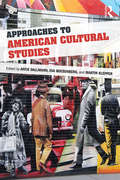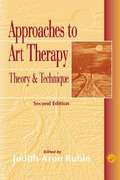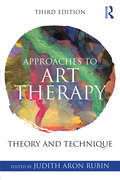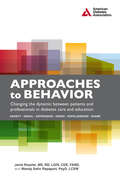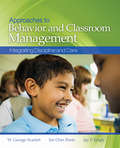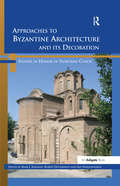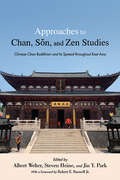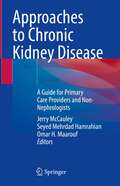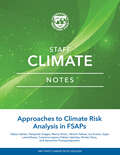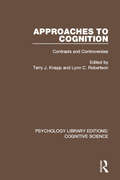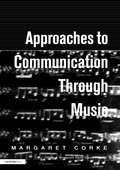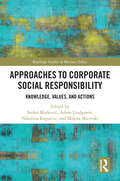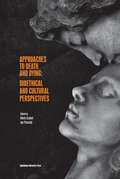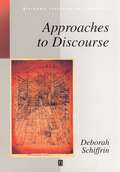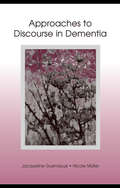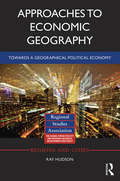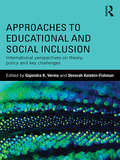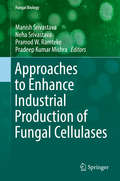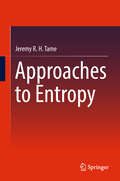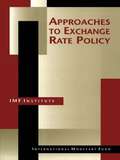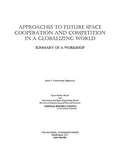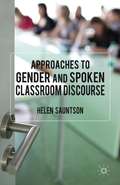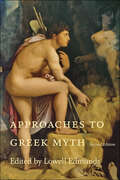- Table View
- List View
Approaches to American Cultural Studies
by Antje Dallmann Eva Boesenberg Martin KlepperApproaches to American Cultural Studies provides an accessible yet comprehensive overview of the diverse range of subjects encompassed within American Studies, familiarising students with the history and shape of American Studies as an academic subject as well as its key theories, methods, and concepts. Written and edited by an international team of authors based primarily in Europe, the book is divided into four thematically-organised sections. The first part delineates the evolution of American Studies over the course of the twentieth century, the second elaborates on how American Studies as a field is positioned within the wider humanities, and the third inspects and deconstructs popular tropes such as myths of the West, the self-made man, Manifest Destiny, and representations of the President of the United States. The fourth part introduces theories of society such as structuralism and deconstruction, queer and transgender theories, border and hemispheric studies, and critical race theory that are particularly influential within American Studies. This book is supplemented by a companion website offering further material for study (www.routledge.com/cw/dallmann). Specifically designed for use on courses across Europe, it is a clear and engaging introductory text for students of American culture.
Approaches to Art Therapy
by Judith Aron RubinThe second edition of the highly successful 1987 book brings together the varied theoretical approaches to art therapy, and provides a variety of solutions to the challenge of translating theory to technique. In each chapter, the esteemed contributors, experts in the approach of the particular chapter, provide a definition of and orientation to the specific theory or area of emphasis, showing its relevance to art therapy. Clinical examples and nearly 100 illustrations are employed as the authors present the creative and effective treatment of patients.In addition to the strength of the theoretical overview, this new edition offers many new chapters including those on cognitive-behavioral therapy and person-centered therapy. The text is divided into five sections: psychodynamic approaches; humanistic approaches; psycho-educational approaches; systemic approaches; and integrative approaches. Commentaries by well known art therapists follow each section of the book. Art therapists at all levels, as well as any mental health professional utilizing art in their clinical work, will find this new edition of value and interest.
Approaches to Art Therapy: Theory and Technique
by Judith Aron RubinThe third edition of Approaches to Art Therapy brings together varied theoretical approaches and provides a variety of solutions to the challenge of translating theory to technique. In each chapter, the field's most eminent scholars provide a definition of and orientation to the specific theory or area of emphasis, showing its relevance to art therapy. The third edition includes many new chapters with material on a wide variety of topics including contemplative approaches, DBT, neuroscience, and mentalization while also retaining important and timeless contributions from the pioneers of art therapy. Clinical case examples and over 100 illustrations of patient artwork vividly demonstrate the techniques in practice. Approaches to Art Therapy, 3rd edition, is an essential resource in the assembly of any clinician's theoretical and technical toolbox, and in the formulation of each individual's own approach to art therapy.
Approaches to Assessing Intake of Food and Dietary Supplements in Pregnant Women and Children 2 to 11 Years of Age: Proceedings Of A Workshop Series
by Food and Nutrition Board National Academies of Sciences, Engineering, and Medicine Health and Medicine DivisionA virtual workshop series titled Approaches to Assessing Intake of Food and Dietary Supplements in Pregnant Women and Children 2 to 11 Years of Age was convened in May, 2021 by the Food and Nutrition Board of the National Academies of Sciences, Engineering, and Medicine. The four-day workshop series explored the evidence on methodological approaches to assessing intake of food and dietary supplements in pregnant women and children 2 to 11 years of age. Obtaining reliable and valid dietary intake information for these population groups is particularly difficult - in pregnancy, rapid changes in nutrient needs and dietary intakes occur, and in young children, much of dietary intake is consumed outside the home and is often misreported by the children or their proxy reporters. To advance the quality of the science in these areas, the workshop had four goals: identify the suite of current methods used in dietary assessments, including food and dietary supplements, in pregnant women and children 2 to 11 years of age; identify the methodological challenges and opportunities in improving current methods; explore methodologies in other disciplines and their application in dietary assessments in those populations; and discuss factors to consider when implementing dietary assessment tools in those populations. This publication summarizes the presentations and discussions of the workshop series.
Approaches to Behavior
by Janis Roszler Wendy S. RapaportApproaches to Behavior provides information and simple tools that healthcare professionals can use to help patients move beyond feelings that prevent them from benefiting fully from any learning opportunity. Each chapter opens with an introduction to experts' newest psychological understanding about a common emotion. This is followed by a list of easy techniques healthcare professionals can employ with their patients. Each technique was contributed by experienced mental health experts who counsel people with diabetes. None of these techniques can take the place of the in-depth guidance mental healthcare professionals provide. Instead, this book is a first aid kit that experts can use to help patients start to move past strong emotions and become more receptive to vital information that will improve their lives and help them take control of their diabetes.
Approaches to Behavior and Classroom Management: Integrating Discipline and Care
by Dr W. George Scarlett Iris Chin Ponte Jay P. SinghApproaches to Behavior and Classroom Management focuses on helping teachers use a variety of approaches in behavior and classroom management in order to make good decisions when faced with the challenge of creating positive classroom communities. Today's classrooms often include children from a variety of backgrounds and with different needs - needs that must be met if these children are to thrive in school. This text will provide teachers and other educators with the historical and cultural framework necessary to understand approaches to behavior and classroom management, a deep understanding of each approach, and a tool belt of relevant methods from which to choose to meet the needs of various situations.Ancillaries available, including:Instructor's Resource CD-ROM (for qualified instructors)Student Resource CD-ROMStudent Study Site (www.sagepub.com/scarlettstudy)
Approaches to Byzantine Architecture and its Decoration: Studies in Honor of Slobodan Curcic
by Mark J. Johnson Amy PapalexandrouThe fourteen essays in this collection demonstrate a wide variety of approaches to the study of Byzantine architecture and its decoration, a reflection of both newer trends and traditional scholarship in the field. The variety is also a reflection of Professor Curcic’s wide interests, which he shares with his students. These include the analysis of recent archaeological discoveries; recovery of lost monuments through archival research and onsite examination of material remains; reconsidering traditional typological approaches often ignored in current scholarship; fresh interpretations of architectural features and designs; contextualization of monuments within the landscape; tracing historiographic trends; and mining neglected written sources for motives of patronage. The papers also range broadly in terms of chronology and geography, from the Early Christian through the post-Byzantine period and from Italy to Armenia. Three papers examine Early Christian monuments, and of these two expand the inquiry into their architectural afterlives. Others discuss later monuments in Byzantine territory and monuments in territories related to Byzantium such as Serbia, Armenia, and Norman Italy. No Orthodox church being complete without interior decoration, two papers discuss issues connected to frescoes in late medieval Balkan churches. Finally, one study investigates the continued influence of Byzantine palace architecture long after the fall of Constantinople.
Approaches to Chan, Sŏn, and Zen Studies: Chinese Chan Buddhism and Its Spread throughout East Asia (SUNY series in Chinese Philosophy and Culture)
by Albert Welter; Steven Heine; Jin Y. ParkThis volume focuses on Chinese Chan Buddhism and its spread across East Asia, with special attention to its impacts on Korean Sŏn and Japanese Zen. Zen enthralled the scholarly world throughout much of the twentieth century, and Zen Studies became a major academic discipline in its wake. Interpreted through the lens of Japanese Zen and its reaction to events in the modern world, Zen Studies incorporated a broad range of Zen-related movements in the East Asian Buddhist world. As broad as the scope of Zen Studies was, however, it was clearly rooted in a Japanese context, and aspects of the "Zen experience" that did not fit modern Japanese Zen aspirations tended to be marginalized and ignored. Approaches to Chan, Sŏn, and Zen Studies acknowledges the move beyond Zen Studies to recognize the changing and growing parameters of the field. The volume also examines the modern dynamics in each of these traditions.
Approaches to Chronic Kidney Disease: A Guide for Primary Care Providers and Non-Nephrologists
by Jerry McCauley Seyed Mehrdad Hamrahian Omar H. MaaroufChronic kidney disease (CKD) is a major global public health problem, affecting nearly one in seven adults in the United States alone. It is a disease that integrates chronic illness at several levels, and the progressive condition is associated with high rates of co-morbidity. This text provides a comprehensive, current state-of-the art review of this field, serving as a valuable resource for primary care providers and non-nephrology clinicians that treat patients with CKD. It is comprised of 24 chapters focused on specific aspects of the disease. The first 2 chapters provide a bit of background on the disease, describing the anatomy and physiology of the kidney as well as the definition and epidemiology of the disease. The following 3 chapters discuss the detection, prevention and progression of the disease. The next 6 chapters describe the relationship of the disease with other conditions and most common co-morbidities such as diabetes and hypertension. The chapters, that follow focus on the CKD associated complications and the CKD within special populations such as the elderly and minorities as well as dietary restrictions and drug dosing. The book concludes with discussion on preparation for renal replacement therapy and preemptive organ transplantation as an alternative to dialysis in the management of the advanced CKD. Written by experts in the field, Approach to Chronic Kidney Disease is a comprehensive guide for clinicians, especially primary care providers including residents and fellows in training, who take care of chronic kidney disease patients. It is also a useful tool for researchers dealing with this challenging field.
Approaches to Climate Risk Analysis in FSAPs (Staff Climate Notes Ser.)
by PanagiotopoulosA report from the International Monetary Fund.
Approaches to Cognition: Contrasts and Controversies (Psychology Library Editions: Cognitive Science)
by TERRY J. KNAPP AND LYNN C. ROBERTSONTo the vast majority of academic psychologists in the 1980s, the study of cognition referred to that area of psychology known as ‘cognitive psychology’. The major basis of this area had been the computer metaphor with its accompanying notion of the individual as an information-processing system. Yet within the field the study of cognition is much broader and has a history that reaches into antiquity, whereas ‘cognitive psychology’ as information-processing psychology had only recently become the standard bearer of cognitive studies. One of the purposes of this volume, originally published in 1986, was to articulate some of the fundamental distinctions between and concordances among different orientations concerning the study of cognition. The collection includes chapters on information processing, ecological, Gestalt, physiological, and operant psychology.
Approaches to Communication through Music
by Margaret CorkeOne of the ways forward when working with those who have little or no speech, or limited comprehension of language, is to use music. In this book tried and tested approaches and activities devised to promote the development of communication and social interaction at a fundamental level are clearly set out. The ethos behind this manual is a person-centered approach, within a structured framework and allowing for differentiation and improvisation according to the learner's individual needs and developmental levels. This is a practical guide that contains lots of ideas and original activities for the specialist and non-specialist alike. It provides original songs and music scores, activities and games, and suggestions for group work for learners at a variety of levels.This book will be helpful to teachers, carers, therapists and parents who work or live with people with severe or profound and multiple learning difficulties. Music teachers and coordinators working in mainstream early years and primary education will also find the songs and activities useful.
Approaches to Corporate Social Responsibility: Knowledge, Values, and Actions (Routledge Studies in Business Ethics)
by Adam Lindgreen Nikolina Koporcic Stefan Markovic Milena MicevskiFollowing recent growth of ethical consumerism, customers and other stakeholders increasingly pressure organizations to be socially responsible and minimize their negative impact on the environment. Accordingly, a plethora of firms have integrated corporate social responsibility (CSR) at the center of their business strategies and actions. Whilst this has resulted in many firms meeting their broader responsibilities toward society and the environment, some firms have used CSR in a manipulative and insincere way. As stakeholders become aware of such misuse of CSR, largely thanks to the rapid evolution of information technologies, they start to penalize firms by spreading negative word of mouth about them, and specifically about their CSR knowledge, values, and actions. Now, more than ever before, stakeholders are increasingly critical and cautious in their assessments of firms’ CSR knowledge, values, and actions. On this background, this edited volume sheds light on different internal and external perspectives spanning CSR knowledge, values, and actions. It shares theoretical, practical, and case-based insights on the broader topic and can be of interest to researchers, academics, practitioners, and advanced students in the fields of CSR and business ethics, knowledge management, strategy, and marketing.
Approaches to Death and Dying: Bioethical and Cultural Perspectives
by Jan Piasecki Marta SzabatThe book Approaches to Death and Dying: Bioethical and Cultural Perspectives, edited by Marta Szabat and Jan Piasecki, is part of a still too narrow catalogue of works devoted to end-of-life themes. The volume consists of eleven articles arranged in four parts corresponding to a broad range of issues: law, ethics, philosophy, and cultural studies. The arrangement of the book is thus constructed around various perspectives upon which any reflection on death and dying must be based. This is perhaps indicative of how difficult it is to adopt an unambiguous attitude towards death–modernity, which introduces a multitude of possible choices and decisions regarding our own bodies, has enhanced individualism but at the same time done away with the order provided by old customs, cultural arrangements, strategies towards the inevitable and the power exerted by that order.
Approaches to Discourse (Blackwell Textbooks in Linguistics)
by Deborah Schiffrin<p>This is a guide to the various frameworks, concepts, and methods available for the analysis of discourse within linguistics. It compares six dominant approaches to discourse analysis: speech act theory, pragmatics, ethnomethodology, interactional sociolinguistics, ethnography of communication, and variation theory. <p>The author not only considers each approach from several standpoints but she also illustrates them through extensive applications to a variety of concrete social and linguistic problems facing discourse analysts.</p>
Approaches to Discourse in Dementia
by Nicole Muller Jacqueline A. GuendouziThe qualitative analysis of naturally occurring discourse in neurogenic communication disorders, specifically in dementia studies, has experienced recent burgeoning interest from wide-ranging disciplines. This multidisciplinarity has been exciting, but has added contextual confusion. This book advances the study of discourse in dementia by systematically exploring and applying different approaches to the same free conversational data sets, collected and transcribed by the authors. The applied methodologies and theories comprise a useful sourcebook for students, researchers, and practitioners alike.
Approaches to Economic Geography: Towards a geographical political economy (Regions and Cities)
by Ray HudsonThe last four decades have seen major changes in the global economy, with the collapse of communism and the spread of capitalism into parts of the world from which it had previously been excluded. Beginning with a grounding in Marxian political economy, this book explores a range of new ideas as to what economic geography can offer as it intersects with public policy and planning in the new globalised economy. Approaches to Economic Geography draws together the formidable work of Ray Hudson into an authoritative collection, offering a unique approach to the understanding of the changing geographies of the global economy. With chapters covering subjects ranging from uneven development to social economy, this volume explores how a range of perspectives, including evolutionary and institutional approaches, can further elucidate how such economies and their geographies are reproduced. Subsequent chapters argue that greater attention must be given to the relationships between the economy and nature, and that more consideration needs to be given to the growing significance of illegal activities in the economy. The book will be of interest to students studying economic geography as well as researchers and policy makers that recognise the importance of the relationships between economy and geography as we move towards a sustainable future economy and society.
Approaches to Educational and Social Inclusion: International perspectives on theory, policy and key challenges
by Devorah Kalekin-Fishman Gajendra K. VermaIn this insightful text, the editors reflect on contributions from scholars representing Bangladesh, Greece, India, Israel, New Zealand, Switzerland, UK and USA, by showing how the majority of educational and social institutions in both developed and developing countries have failed to overcome the many barriers to an effective integrated system of education, suggesting ways as to how these barriers might be challenged. By looking closely at the overt and covert injuries of educational and social exclusion, a variety of approaches to overcoming the consequences of those challenges is proposed, drawing together strands of social theory, research data and conceptualisations for social action.
Approaches to Enhance Industrial Production of Fungal Cellulases (Fungal Biology)
by Neha Srivastava Manish Srivastava Pramod W. Ramteke Pradeep Kumar MishraCellulase is a key enzyme of industrial interest and plays a crucial role in the hydrolysis of cellulose, a prime component of plant cell walls. Cellulase covers a broad area in the global market of industrially important enzymes and it is considered as the third largest industrial enzyme globally. Additionally, cellulase contributes about 20% of the total enzyme market globally because of its massive demand in various industries such as in biofuel production, pulp, paper, textile, food, and beverages, as well as in detergent industries. Among these, the demand of cellulase may become frequently selected in the commercial production of biofuels in the future and thus will further increase demand of cellulase in the biofuel industry. Because biofuel production is still not realized in a cost-effective, practical implementation due to its high cost (the higher cost of biofuels is due to higher production costs of enzymes), there is a need to introduce these types of approaches, which will help to lower the cost of enzyme production for developing overall economic biofuel production.
Approaches to Entropy
by Jeremy R. TameThis is a book about thermodynamics, not history, but it adopts a semi-historical approach in order to highlight different approaches to entropy. The book does not follow a rigid temporal order of events, nor it is meant to be comprehensive. It includes solved examples for a solid understanding. The division into chapters under the names of key players in the development of the field is not intended to separate these individual contributions entirely, but to highlight their different approaches to entropy. This structure helps to provide a different view-point from other text-books on entropy.
Approaches to Exchange Rate Policy
by International Monetary FundA report from the International Monetary Fund.
Approaches to Future Space Cooperation and Competition in a Globalizing World: Summary of a Workshop
by National Research Council of the National AcademiesNumerous countries and regions now have very active space programs, and the number is increasing. These maturing capabilities around the world create a plethora of potential partners for cooperative space endeavors, while at the same time heightening competitiveness in the international space arena. This book summarizes a public workshop held in November 2008 for the purpose of reviewing past and present cooperation, coordination, and competition mechanisms for space and Earth science research and space exploration; identifying significant lessons learned; and discussing how those lessons could best be applied in the future, particularly in the areas of cooperation and collaboration. Presentations and initial discussion focused on past and present experiences in international cooperation and competition to identify "lessons learned." Those lessons learned were then used as the starting point for subsequent discussions on the most effective ways for structuring future cooperation or coordination in space and Earth science research and space exploration. The goal of the workshop was not to develop a specific model for future cooperation or coordination, but rather to explore the advantages and disadvantages of various approaches and stimulate further deliberation on this important topic.
Approaches to Gender and Spoken Classroom Discourse
by Helen SauntsonGender is a hotly debated topic in the field of education. The role that language plays in educational contexts especially in the classroom has long been acknowledged. Innovatively combining approaches in the analysis of classroom discourse this book offers rich empirical findings as well as being theoretically interesting and valuable.
Approaches to Geo-mathematical Modelling: New Tools for Complexity Science
by Alan WilsonGeo-mathematical modelling: models from complexity science Sir Alan Wilson, Centre for Advanced Spatial Analysis, University College London Mathematical and computer models for a complexity science tool kit Geographical systems are characterised by locations, activities at locations, interactions between them and the infrastructures that carry these activities and flows. They can be described at a great variety of scales, from individuals and organisations to countries. Our understanding, often partial, of these entities, and in many cases this understanding is represented in theories and associated mathematical models. In this book, the main examples are models that represent elements of the global system covering such topics as trade, migration, security and development aid together with examples at finer scales. This provides an effective toolkit that can not only be applied to global systems, but more widely in the modelling of complex systems. All complex systems involve nonlinearities involving path dependence and the possibility of phase changes and this makes the mathematical aspects particularly interesting. It is through these mechanisms that new structures can be seen to 'emerge', and hence the current notion of 'emergent behaviour'. The range of models demonstrated include account-based models and biproportional fitting, structural dynamics, space-time statistical analysis, real-time response models, Lotka-Volterra models representing 'war', agent-based models, epidemiology and reaction-diffusion approaches, game theory, network models and finally, integrated models. Geo-mathematical modelling: Presents mathematical models with spatial dimensions. Provides representations of path dependence and phase changes. Illustrates complexity science using models of trade, migration, security and development aid. Demonstrates how generic models from the complexity science tool kit can each be applied in a variety of situations This book is for practitioners and researchers in applied mathematics, geography, economics, and interdisciplinary fields such as regional science and complexity science. It can also be used as the basis of a modelling course for postgraduate students.
Approaches to Greek Myth
by Lowell EdmundsNow thoroughly revised and updated, this volume offers a variety of historical, comparative, and theoretical perspectives on Greek myth.Since the first edition of Approaches to Greek Myth was published in 1990, interest in Greek mythology has surged. There was no simple agreement on the subject of "myth" in classical antiquity, and there remains none today. Is myth a narrative or a performance? Can myth be separated from its context? What did myths mean to ancient Greeks and what do they mean today? Here, Lowell Edmunds brings together practitioners of eight of the most important contemporary approaches to the subject. Whether exploring myth from a historical, comparative, or theoretical perspective, each contributor lucidly describes a particular approach, applies it to one or more myths, and reflects on what the approach yields that others do not. Edmunds's new general and chapter-level introductions recontextualize these essays and also touch on recent developments in scholarship in the interpretation of Greek myth. Contributors are Jordi Pàmias, on the reception of Greek myth through history; H. S. Versnel, on the intersections of myth and ritual; Carolina López-Ruiz, on the near Eastern contexts; Joseph Falaky Nagy, on Indo-European structure in Greek myth; William Hansen, on myth and folklore; Claude Calame, on the application of semiotic theory of narrative; Christiane Sourvinou-Inwood, on reading visual sources such as vase paintings; and Robert A. Segal, on psychoanalytic interpretations.
